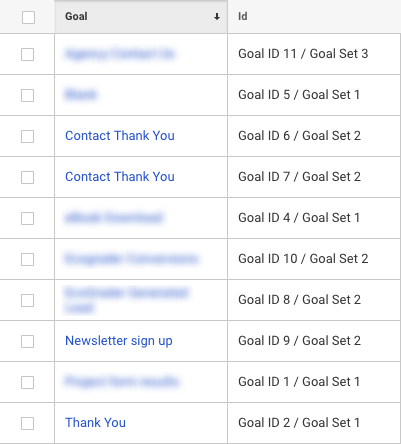Unveiling the Blind Attractions: Recognizing What Google Analytics Goals Can not Gauge
In the world of digital analytics, Google Analytics stands as an effective device for monitoring and evaluating online user communications. Understanding what Google Analytics goals can not determine is critical for obtaining a detailed sight of user habits and engagement.
Customer Behavior on External Platforms
Recognizing exactly how users engage on external platforms is essential for maximizing on-line techniques. External systems, such as social media sites networks, referral websites, and online forums, play a considerable duty in driving website traffic to a business's site. By analyzing individual habits on these platforms, companies can obtain important insights right into the efficiency of their advertising initiatives and the preferences of their target market.
One key aspect of customer behavior on outside platforms is the referral source. By tracking where the users are originating from, services can identify which systems are driving one of the most traffic to their internet site. This details can assist business assign their sources extra successfully, concentrating on the platforms that produce the very best outcomes.

Offline Conversions and Communications
Assessing individual behavior on outside platforms offers valuable insights right into online techniques; nevertheless, thinking about offline conversions and interactions is just as crucial for a comprehensive understanding of a business's overall efficiency. Offline conversions, such as in-store purchases or phone queries, play a considerable duty in numerous companies' success.

Acknowledgment Beyond Last Click
When diving into the realm of electronic advertising and marketing analytics, it becomes essential to look beyond the solitary touchpoint of the last click for a much more detailed understanding of acknowledgment. While Google Analytics provides valuable insights into customer behavior, counting exclusively on last-click acknowledgment can be restricting - what data is google analytics goals unable to track. Acknowledgment models that exceed the last click use a much more nuanced view of the client journey, considering all the touchpoints that result in a conversion
Acknowledgment beyond the last click allows marketers to designate credit scores to various communications along the conversion course, offering a clearer image of the efficiency of various advertising networks. By exploring multi-touch acknowledgment versions such as straight, time decay, or position-based attribution, businesses can much better designate their advertising and marketing spending plans and optimize their strategies for optimal impact.
Recognizing the impact of each touchpoint in the conversion procedure is essential for making notified choices and taking full advantage of ROI. By embracing acknowledgment beyond the last click, services can get deeper understandings into customer actions and customize their advertising and marketing initiatives better.
Cross-Device and Cross-Browser Tracking

Likewise, cross-browser tracking enhances cross-device tracking by catching individual habits as they change between various internet internet browsers. Comprehending how individuals connect with internet sites on different web browsers can aid online marketers enhance their on-line experiences to ensure uniformity and functionality across different systems.
Qualitative Data and User Intent
Understanding user intent through qualitative information evaluation is important for establishing targeted electronic advertising methods that resonate visit their website with the needs and preferences of the target market. Qualitative information offers understandings right into the 'why' behind individual activities, clarifying inspirations, emotions, and preferences that quantitative information alone can not capture. By analyzing customer responses, comments, and interactions, marketing experts can uncover useful info concerning customer intent, allowing them to customize their messaging, material, and offerings to much better straighten with what their audience is seeking.
Qualitative data likewise aids in comprehending the context in which users involve with a web site or application. This contextual understanding enables marketing experts to produce more pertinent and customized experiences, eventually driving greater involvement and conversion rates. By diving into individual intent with qualitative information analysis, businesses can get a deeper understanding of their target market, causing more efficient marketing techniques that meet customers' requirements and expectations.
Verdict
Finally, Google Analytics objectives have restrictions in gauging customer habits on outside systems, offline conversions, acknowledgment beyond last click, cross-browser and cross-device tracking, and qualitative data connected to customer intent. what data is google analytics goals unable to track. It is necessary for organizations to be knowledgeable about these dead spots in order to supplement their data evaluation with other tools and techniques to obtain an extra thorough understanding of their audience and enhance their overall electronic advertising methods
By evaluating customer habits on these platforms, organizations can get beneficial understandings into the performance of their advertising and marketing efforts and the preferences of their target audience.
Assessing customer behavior on outside systems supplies important understandings right into on the internet strategies; however, thinking about offline conversions and interactions is equally necessary for an extensive understanding of a business's total efficiency.In electronic marketing analytics, moving beyond last-click attribution to explore cross-device and this hyperlink cross-browser tracking is crucial for gaining a holistic understanding of user communications across numerous systems and tools. By evaluating user feedback, remarks, and interactions, marketers can discover useful information about individual intent, allowing them to tailor their messaging, material, and offerings to much better align with what their audience is seeking.
By delving into user intent with qualitative information analysis, services can acquire a deeper understanding of their target audience, leading to a lot more reliable marketing techniques that fulfill individuals' requirements and assumptions.
 Nancy Kerrigan Then & Now!
Nancy Kerrigan Then & Now! Suri Cruise Then & Now!
Suri Cruise Then & Now! Batista Then & Now!
Batista Then & Now! Jaclyn Smith Then & Now!
Jaclyn Smith Then & Now! Nicholle Tom Then & Now!
Nicholle Tom Then & Now!